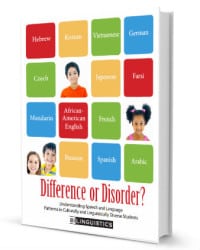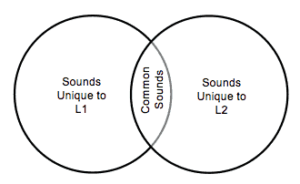We did it! After years and years of gathering information about different languages in the course of our jobs as bilingual speech-language pathologists, we finally turned it all into a book. Difference or Disorder? Understanding Speech and Language Patterns in Culturally and Linguistically Diverse Students.

ASHA Presentation and Booth
We’ll be talking about our book and much more at our presentation, “Are these errors due to native language influence?,” at the ASHA Convention in Orlando on Thursday, November 20, 2014 from 3pm to 4pm in Hyatt/Plaza Ballroom DE. We hope you can join us. We’ll be in Booth 1474 in the Exhibit Hall if you want to come by and check out Difference or Disorder?.
A bit about the book
At Bilinguistics, we are all bilingual, but most of us are monolingual when it comes to evaluating children in Korean, German, and Japanese. It is because of our knowledge base about bilingual language development that we get asked to evaluate students in many languages. In fact, just this week we got calls about Tosk (a dialect of Albanian) and Pashto, one of the two official languages of Afghanistan. I imagine the next edition of the book will be much thicker as we continue to add languages to it.
Thanks to you!
The drive to create this book came from all of you. We so frequently hear from awesome speech-language pathologists who want to do a great job on their evaluations. Many we have spoken with over the years have said, “I just don’t know if this student’s struggles are a result of language influence from his native language or not.” This book is designed to help you. You will feel confident about your diagnostic decisions.
Inside the book
We compared 12 languages and African-American English to Standard American English to show you similarities and differences in sounds and language structures. We also show you what common cross-linguistic errors look like. Where there are similarities in two languages, we expect positive transfer of those skills to the new language. In other words, we do not expect errors. Where there are differences in two languages, it is common to see English language learners use their knowledge of their native language in the production of English. They make predictable errors. If all of their errors are predictable, the likelihood is that they do not have a speech impairment or language impairment. If they make a lot of errors that are not predictable, this is an indication for concern.
One chapter is dedicated to this framework, which you can apply to any pair of languages. We also devote some attention to cultural differences and the way they can influence diagnostic decisions. For the 12 languages and one English dialect included in the book, we’ve done the research for you. We’ve scoured theses, dissertations, journal articles, archives, and the internet for all of the information we could find on these languages. We’ve laid it out in an easy-to-use format.
And this isn’t just for speech-language pathologists. We are supporting teachers, too. We highlight the differences in the languages to help teachers of English language learners identify their instructional target. Watch this video of a 4th grade teacher who has two Arabic-speaking students in her class.
Easily Identify Which Sounds Are Influenced by a Child’s Second Language

We, like you, work with interpreters to complete evaluations of children who speak languages we don’t. The information in this book helps us show the interpreter what we are looking for. Most interpreters do not know off of the top of their heads which phonemes exist in English that do not exist in the other language they speak. When we can show them a picture of what this looks like, it helps them help us make good diagnostic decision. We present Venn diagrams of the unique and shared sounds of each language that make our jobs easier.
We created these to make our jobs easier. And we want to make your job easier too. Check out a preview of the book and let us know what you think.





What an exciting resource you have created! Thank you so much. This is an issue I deal with on a daily basis in my work as a bilingual SLP in the secondary school setting working with many bilingual students. When will this book be available for purchase? Thank you!
This book is now available. View it on our products page.
I love this resource and its format! SO easy to share with teachers and others teaching our ELL students.
Have you by chance created a summary for Ukrainian, Turkish, Teluga or Burmese?
Glad you like it and so happy to hear it is easy to use with your team.